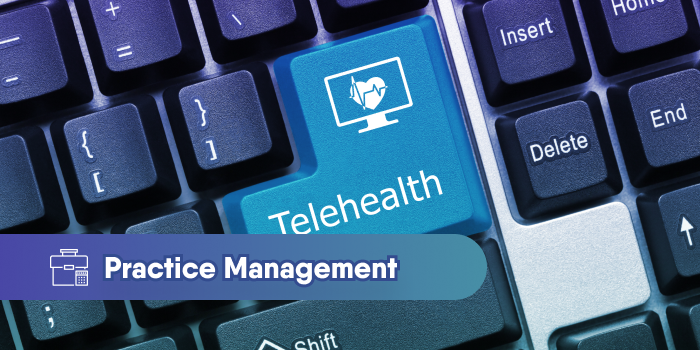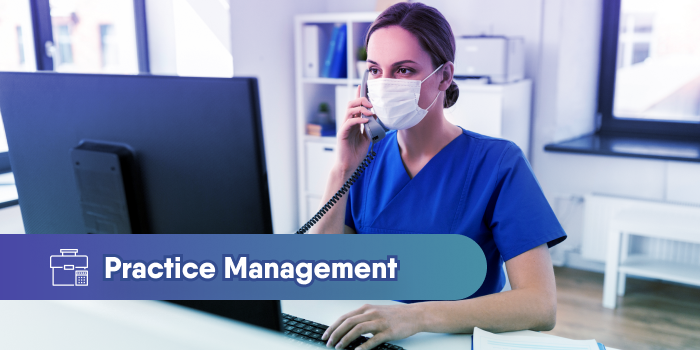How Telehealth Technology Improves Clinical Workflow
Healthcare professionals (HCPs) consider finding a way to improve healthcare quality in the United States a critical undertaking to succeed in...

Your medical practice needs practice management tools to help you improve healthcare delivery efficiency, boost patient satisfaction, and increase revenue generation.
Have you ever wondered why, despite your staff working late and spending hours on phone calls and paperwork, your office still struggles with administrative tasks piling up, appointment mistakes, no-shows, and unhappy patients? Perhaps, it's time you consider appropriate practice management tools to help increase healthcare delivery efficiency.
Healthcare professionals face this common medical practice challenge. As one of the largest service industries in the United States, healthcare, with an estimated revenue of over $2.6 billion in 2020, wastes billions because of clinical inefficiency.
Yes, resolving the issue is critical. Practice management tools for your office offer a solution.
We know how stressful it is for you to choose practice management software or other tools. But, it can also be exciting to have healthcare tech, the carefully selected tools your office requires.
Read on, and take the time to learn which software addresses the office inefficiencies you strive to overcome in your practice.
Remember, implementing the right technology in your medical practice improves efficiency in your office, which, in turn, keeps operation costs low and profits high. Also important: It promotes a positive patient experience and results in increased patient satisfaction scores.
To simplify your options in finding the right technology for your practice, you have to identify which inefficiencies you need tools for to improve. And what better way to do this than through a patient-centric approach.
A patient's experience with your practice is a credible testimonial to your office's efficiency or the lack of it. Patient satisfaction reflects how your team works to provide timely, efficient, and patient-centered quality health care. Therefore, with patients as your indicator, you either have a patient complain about a negative incident, a constantly decreasing number of patient visits, or the opposite of both.
Track down inefficiencies by considering the entire patient care process — when and where patients engage your team. Patients contact your office, for example, in different instances — previsit, during the visit, and after their visit. Inefficiencies can happen in the front office, back office, the doctor's consultation, or examination room.
Common inefficiencies include:
Let’s dive into each further.
Scheduling patient visits, which is time-consuming, is the most prevalent inefficiency source. Despite the time and effort spent booking appointments, 30% end in no-shows, while some patients cancel or reschedule due to a scheduling conflict or patient tardiness.
Recommendations to improve patient booking:
Setting up patient visits is easier with the correct scheduling and booking software to match patient-doctor schedules. A practice management software (PMS) is capable of doing such tasks. Then, integrate it with a secure 2-way text messaging platform to allow patients to book, cancel and reschedule appointments by simply texting. These tools also allow you to set up automated smart reminders and dramatically reduce patient no-shows by up to 50%.
Receiving a high phone call volume affects office productivity by taking your staff's valuable time from more important tasks like attending to in-office patient concerns or staying on schedule checking in patients. Callers may grow angry if left on hold for too long or if it takes too long for your staff to answer. Patients in the waiting room don’t like being interrupted because a call comes in either. Your staff has to find a way to dismiss phone queries politely if they don't have answers yet, or schedule a follow-up call if they can't yet confirm something because the doctor is attending to another patient. They also have to make sure patients in the waiting room remain happy.
In numerous cases, this leads to high call abandonment rates, low returned calls and messages, long hold times, and ineffective use of staff time.
Recommendations to improve communication:
Implement a text messaging option for patients to reach your medical practice and reduce phone call volume by up to 75%. A 2-way text messaging system allows your patients to contact you and get a response, almost instantly, about any concerns or needs they have without being put on hold. Your staff is also relieved from the hassle of voluminous phone calls, making them more productive and attentive to patients in the office.
It is very time-consuming for practices to verify insurance eligibility before or during a patient visit. Your staff needs to check a patient's active insurance coverage, referrals and copays, of course. The process becomes complex, though, for patients with coverage through Medicaid or the State Children's Health Insurance Program (CHIP) as they change their eligibility rules frequently.
Recommendation to speed up insurance verification:
Practice management software can do so much more than set up appointments for you. It can also do insurance card scanning and verify insurance eligibility. The technology is so efficient that it can do these tasks in seconds or minutes, saving your staff hours of phone calls and waiting.
All these previsit inefficiencies result in patients being irritated even before their actual visits, and your staff loses morale and becomes exhausted.
Communication is important for medical practices’ staff to deliver exceptional patient care. They must be able to communicate with each other without delay. In some instances, providers need to communicate among themselves for referrals and additional patient information.
However, there may be inefficiency in the lack of standard and reliable access to medical records. Patient's medical records, like in electronic health records (EHRs), have reporting modules, which may not allow a practice to retrieve data and present them as needed. It makes communication a lot harder.
Recommendation to improve medical record access:
Make communications between you and your team seamless and with other providers easy. A fully featured HIPAA-compliant text messaging system that integrates with any EHR makes internal communication flawless and enables you to exchange relevant information anytime with the right staff and colleagues.
Another common source of inefficiency is poor human resource management. That includes the inappropriate division of tasks between teams, poor workflow, inadequate interaction or dialogue between staff members, difficulty adapting when employees are out sick or on vacation, and the team being territorial over duties.
Recommendation to improve delegation: Communication is the solution here. Once you establish a secure communications highway within your practice, it becomes easier for you to delegate tasks and your staff to fill in or assume duties. Easy to use internal communication software allows your team to maximize channels of dialogues for coordination, to speed up requests, follow-up on reports, etc.
Handling medication refill requests is a high-volume, repetitive task in healthcare offices with many steps and opportunities for error. Either an in-person or phone request, this task is an addition to the already time-constrained medical practice.
Recommendation to decrease prescription refill time:
Electronic prescription software saves you from this redundant task by automating the entire prescribing process.
Medical practices maximize payments from third-party payers, hoping to increase productivity by saving time collecting directly from patients. However, dealing with payers takes enormous staff time. Your office needs to frequently contact payers regarding prior authorization for specific services, referrals, etc. Care guidelines and billing requirements vary between payers, too.
Recommendation to decrease third-party accounts receivables:
A medical billing and collection software is the tool you need for this concern. It saves a significant amount of time over manually contacting third-party payers.
With the variability and the complexity of laboratory tests you may need for a patient, such as blood tests, pathology tests, and radiography, ordering them and managing results are prone to inefficiencies. Delays in test results affect both patients and healthcare practices. Delays may cause distress, delayed treatments, and the inconvenience of repeat tests.
Practices struggle, for instance, with the variety of tests, the number of laboratories performing the tests, the number of different practice team members involved in the process, and the need for test tracking and auditing.
Recommendation to improve management of patient tests:
You can use a laboratory test ordering and results management system or upgrade your PMS to handle the tasks.
Taking all of the common inefficiencies that occur in a healthcare office into consideration, identify what affects your office. Then, you’re ready to implement the practice management technology that can make your office run efficiently.
However minor, efficiencies are still mistakes that impact your practice longer than you expect. Small mistakes create small negative impressions on your patients about your practice and may contribute to building a lousy reputation in the long run.
Remember that patients/customers more quickly leave medical practice reviews over a negative experience than they do over a positive experience.
However, as recommended, you can enhance your office efficiency and lessen human-induced errors and easy mistakes with the right practice management technology.
Technology has been of great help to the healthcare industry since it began to develop cures for illnesses and, later, in developing laboratory and surgical pieces of equipment. Fortunately, software development technology has expanded into medical practices to implement as tools to hasten efficiency in the office.
From the list of inefficiencies above, the choice of tools depends on the functions you need: calendaring, task handling, care management, billing, etc.
With so many tasks in need of efficiency, you likely want a technology that can handle most of them, if not all.
Fortunately, there is such a multi-tasking platform: practice management software or PMS. It manages day-to-day operations in a medical clinic, and its primary functions include the following among other administrative tasks:
A PMS also integrates with other software, and together, they conjoin functions and features, such as billing and payments.
You can, therefore, choose to invest in only one software, but the cost might be high. It might also include additional tasks that you don't need. A large drawback of an all-in-one is that one day, it may fail, affecting all your practice operations.
Your other option is to choose a PMS for particular tasks that you want in one place and another software for other equally important tasks such as billing.
An electronic health record or EHR is the electronic version of a patient's medical history from different practices, including all critical administrative and clinical data relevant to the patient's care, such as demographic, progress notes, illnesses, chronic diseases, medications, vital signs, immunizations, laboratory data, and radiology reports.
EHRs help you easily track your patients' records and update them. It allows you to follow up with your patients on their appointments and medication and send them results by email or phone. It enables you to go back and review the patient's history. It's easy to integrate information from other providers into the system, too.
Less paperwork translates to fewer errors, more free time, and better use of your skills like communicating more with your patients and building trust.
Care management software is a digital healthcare platform that allows patients to access your care team through secure and straightforward 2-way text messaging. It makes scheduling appointments and tracking patient health easier. It also makes it easy to follow their doctor’s designated care plan. Patients can use this technology to manage their care and coordinate with their care team.
This technology eliminates errors associated with poor handwriting and lists all the medications. Digital prescribing software allows physicians to send a patient's prescription to the pharmacy directly. It's a way to keep secure and archive patient data so that their file is complete. It can also help quickly identify patient allergies, potential contraindications, and inform the doctor of these.
Patient portals allow patients the control they deserve in actively participating in their health management. They can seamlessly communicate with your practice without constantly calling your staff to ask questions, request appointments, or update their insurance details with the right tools. The software only requires them to log in to the portal and update their information.
This software allows you to submit claims and receive payments for all your team's hard work. Choose the one suitable for your practice:
Recovery software is a tool you must not disregard even if you feel you don't need it. It is not a necessary tool for direct patient care or office efficiency. It, however, becomes handy in times of software malfunction or accidentally deleting your files. It allows you to backup your files and gives you peace of mind in case technology fails.
Based on the great information above, you can now anticipate, track, and solve inefficiencies in your practice, whether in the front office, the back office, or the doctor's consultation or examination room.
Doctors become the epitome of time management if they set the tone of arriving at the office earlier than the first appointment. You can also minimize inefficiencies when working as a teammate with your staff instead of a "work your way" attitude, resisting standard procedures and learning new things, like practice management technology.
You strive to work hard and improving your medical practice’s productivity can relieve pressure so you can do what you do best, care for patients.. Implementing practice management tools appropriate to your needs that integrate with other available software can keep your office efficiency high.
But make sure it allows you to customize according to your requirements to get the convenience and options you need, like informative and timely reports on performance, revenue, and patient satisfaction, without unnecessary features.
Practice management technology has many tools available. Assess your inefficiencies and choose the tools that make your office excel.

Healthcare professionals (HCPs) consider finding a way to improve healthcare quality in the United States a critical undertaking to succeed in...

Technology is one of the greatest allies of efficiency in the healthcare industry. It has reduced the number of daily manual processes, from patient...

In a demanding and competitive industry, businesses like your medical practice must consistently balance tasks to improve patient satisfaction while...